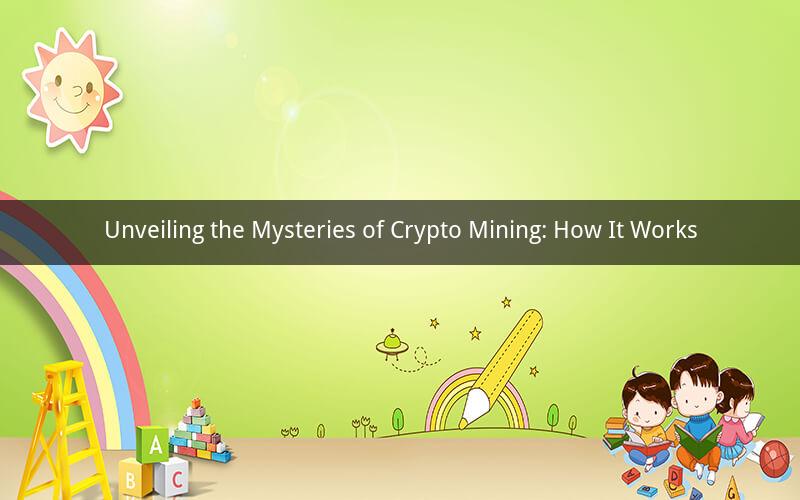
In the digital age, cryptocurrencies have gained immense popularity, and with it, the concept of crypto mining. But what exactly is crypto mining, and how does it work? This article delves into the intricacies of crypto mining, exploring its purpose, process, and the technology behind it.
1. What is Crypto Mining?
Crypto mining refers to the process of validating and adding new transactions to a blockchain. It is a crucial component of the cryptocurrency ecosystem, ensuring the security, integrity, and reliability of digital currencies like Bitcoin, Ethereum, and Litecoin. By mining, participants contribute to the network's consensus mechanism, and in return, they are rewarded with new coins or transaction fees.
2. The Purpose of Crypto Mining
The primary purpose of crypto mining is to maintain the decentralized nature of blockchain networks. By requiring participants to solve complex mathematical problems, the blockchain ensures that no single entity can control or manipulate the network. This decentralized structure fosters trust and eliminates the need for a central authority, making cryptocurrencies resistant to censorship and manipulation.
Moreover, crypto mining serves as a means to introduce new coins into the market. For example, Bitcoin's supply is capped at 21 million coins, and new coins are generated through mining. This scarcity creates a deflationary effect, driving up the value of the cryptocurrency over time.
3. The Process of Crypto Mining
The process of crypto mining involves several steps:
a. Mining Hardware: Miners use specialized computers called ASICs (Application-Specific Integrated Circuits) to solve complex mathematical problems. These devices are designed to perform mining tasks efficiently and are much faster than general-purpose computers.
b. Mining Pools: Due to the high computational power required for mining, many miners join mining pools. A mining pool is a group of miners who work together to solve mathematical problems. When a problem is solved, the rewards are distributed among the pool members based on their contribution.
c. Mining Software: Mining software is used to manage the mining process. It communicates with the mining hardware and the blockchain network, ensuring that the miner's efforts are directed towards solving the next mathematical problem.
d. Proof of Work (PoW): The mining process involves solving a cryptographic puzzle known as Proof of Work. Miners compete to find a solution that satisfies the network's requirements, and the first to find the solution is rewarded with new coins.
4. The Technology Behind Crypto Mining
The technology behind crypto mining is complex and involves several components:
a. Hash Functions: Hash functions are mathematical algorithms that convert data of any size into a fixed-size string of characters. In crypto mining, hash functions are used to create unique identifiers for each transaction and block.
b. Blockchain: A blockchain is a decentralized digital ledger that records all transactions across a network. It consists of blocks, each containing a set of transactions. Once a block is added to the blockchain, it cannot be altered or deleted, ensuring the integrity of the network.
c. Consensus Mechanism: The consensus mechanism is a process by which the network agrees on the validity of transactions and blocks. Proof of Work is one of the most popular consensus mechanisms, but there are others, such as Proof of Stake (PoS).
5. The Challenges of Crypto Mining
Despite its benefits, crypto mining faces several challenges:
a. High Energy Consumption: Mining requires a significant amount of electricity, which can lead to environmental concerns. In fact, some experts believe that Bitcoin mining consumes more energy than entire countries.
b. High Costs: The cost of mining hardware, electricity, and cooling can be prohibitive for many individuals. Moreover, the value of cryptocurrencies can be volatile, affecting the profitability of mining operations.
c. Centralization: As the difficulty of mining increases, larger mining operations and mining pools gain more control over the network. This centralization can undermine the decentralized nature of cryptocurrencies.
Frequently Asked Questions
1. Q: Can anyone participate in crypto mining?
A: Yes, anyone with access to the necessary hardware and software can participate in crypto mining. However, it is essential to research and understand the risks involved before starting.
2. Q: How can I start mining cryptocurrencies?
A: To start mining, you will need a mining rig, mining software, and an internet connection. You can also join a mining pool to increase your chances of earning rewards.
3. Q: Is crypto mining legal?
A: The legality of crypto mining varies by country and region. It is essential to research the laws and regulations in your area before starting a mining operation.
4. Q: How can I maximize my mining profits?
A: To maximize your mining profits, you can optimize your mining rig's performance, choose the right cryptocurrency to mine, and join a mining pool with a good reputation.
5. Q: Can crypto mining be harmful to the environment?
A: Yes, crypto mining can be harmful to the environment due to its high energy consumption. Some experts believe that the environmental impact of mining outweighs the benefits of cryptocurrencies.